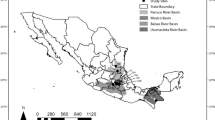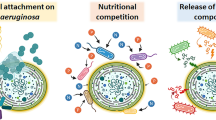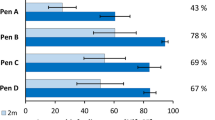Abstract
The aim of this work was to test the efficacy of molecular techniques for detecting toxigenic cyanobacteria in environmental water samples collected from freshwater lakes, rivers and reservoirs in Portugal. Of 26 environmental samples tested, 21 were found to contain Microcystis using a genus-specific polymerase chain reaction (PCR). Another primer pair was applied to the same DNA template to test for the presence of microcystin synthetase genes. This primer pair resulted in the formation of a PCR product in 15 of the samples containing Microcystis and one sample that did not give a positive result in the Microcystis genus-specific PCR. A restriction assay using the enzyme EcoRV was then applied to show that in most cases, the gene fragment was from toxigenic strains of Microcystis and, in one above-mentioned case, from a microcystin-producing strain of Planktothrix. All environmental samples were examined microscopically to confirm the presence of cyanobacteria species. Samples were also tested for the presence of microcystins using the ELISA plate assay. There was good agreement between the results obtained with molecular techniques and those obtained from microscopy and chemical methods. The PCR techniques applied in this paper were found to be useful, particularly when the concentration of the target organism was very low compared with other organisms. This technique can be used to detect inocula for cyanobacterial populations and therefore provide a useful tool for assessing under which conditions particular species can grow into bloom populations.



Similar content being viewed by others
References
Baker P (1991) Identification of common noxious cyanobacteria. Part I—Nostocales. Research Report No. 29, Australian centre for Water Treatment and Water Qual Res
Baker P (1992) Identification of common noxious cyanobacteria. Part II—Chroococcales, Oscillatoriales. Research Report No. 46, Australian centre for Water Treatment and Water Quality Research
Baker JA, Neilan BA, Entsch B, McKay DB (2001) Identification of cyanobacteria and their toxigenicity in environmental samples by rapid molecular analysis. Environ Toxicol 16:472–482
Baker JA, Entsch B, Neilan BA, McKay DB (2002) Monitoring changing toxigenicity of a cyanobacterial bloom by molecular techniques. Appl Environ Microbiol 68:6070–6076
Bittencourt-Oliveira MC (2003) Detection of potential microcystin-producing cyanobacteria in Brazilian reservoirs with a mcyB molecular marker. Harmful Algae 2:51–60
Bourelly P (1970) Les algues déau douce. Initiation à la systematique. Les algues bleues ou cyanophycées. Editions N. Boubée & Cie
Burns BP, Saker ML, Moffitt MC, Neilan BA (2004) Molecular detection of the genes responsible for cyanobacterial toxin production in the genera Microcystis, Nodularia and Cylindrospermopsis. Methods in microbiology, vol. 268. In: Spencer JFT, Ragout de Spencer AL (eds) Public health microbiology: methods and protocols. Humana Press, Totowa, NJ
Christiansen G, Fastner J, Erhard M, Börner T, Dittmann E (2003) Microcystin biosynthesis in Planktothrix: genes, evolution, and manipulation. J Bacteriol 185:564–572
Christiansen G, Kurmayer R, Liu Q, Börner, T (2006) Transposons inactivate biosynthesis of the nonribosomal peptide microcystin in naturally occurring Planktothrix spp. Appl Environ Microbiol 72(1):117–123
Dittmann E, Neilan BA, Erhard M, von Döhren H, Börner T (1997) Insertional mutagenesis of a peptide synthetase that is responsible for hepatotoxin production in the cyanobacterium Microcystis aeruginosa PCC 7806. Mol Microbiol 26:779–787
Falconer IR (2005) Cyanobacterial toxins in drinking water. CRC Press, New York
Hisbergues M, Christiansen G, Rouhiainen L, Sivonen K, Börner T (2003) PCR-based identification of microcystin-producing genotypes of different cyanobacterial genera. Arch Microbiol 180:402–410
Ishida K, Matsuda H, Murakami M, Yamaguchi K (1997) Microginins 299-A and -B, leucine aminopeptidase inhibitors from the cyanobacterium Microcystis aeruginosa (NIES-299). Tetrahedron 53:10281–10288
Ishida K, Matsuda H, Murakami M (1998) Four new microginins, linear peptides from the cyanobacterium Microcystis aeruginosa. Tetrahedron 54:13475–13484
Ishida K, Kato T, Murakami M, Watanabe M, Watanabe MF (2000) Microginins, zinc metalloproteases inhibitors from the cyanobacterium Microcystis aeruginosa. Tetrahedron 56:8643–8656
Kotai J (1972) Instructions for preparation of modified nutrient solution for algae, vol 5. Norwegiean Institute for Water Research, Oslo, Norway, pp 11–69
Kotak BG, Lam AKY, Prepas EE, Kenefick SL, Hrudy SE (1995) Variability of the hepatotoxin microcystin-LR in hypereutrophic drinking water lakes. J Phycol 32:248–263
Kramer D, Dittman E, Börner T (2000) Characterisation of the microginin synthetase gene cluster in the cyanobacterium Microcystis aeruginosa HUB 5.3. In: International symposium on phototrophic prokaryotes, Barcelona, Spain
Kuiper-Goodman T, Falconer I, Fitzgerald J (1999) Human health aspects. In: Chorus I, Bartram J (eds) Toxic cyanobacteria in water. E & FN Spon, London, UK, pp 113–153
Kurmayer R, Dittmann E, Fastner J, Chorus I (2002) Diversity of microcystin genes within a population of the toxic cyanobacterium Microcystis spp. in Lake Wannsee (Berlin, Germany). Microb Ecol 43:107–118
Neilan BA, Jacobs D, Goodman AE (1995) Genetic diversity and phylogeny of toxic cyanobacteria determined by DNA polymorphisms within the phycocyanin locus. Appl Environ Microbiol 61:3875–3883
Neilan BA, Jacobs D, Deldot T, Blackall LL, Hawkins PR, Cox PT, Goodman AE (1997) rRNA sequences and evolutionary relationships among toxic and nontoxic cyanobacteria of the genus Microcystis. Int J Syst Bacteriol 47:693–697
Neumann U, Forchert A, Flury T, Weckesser J (1997) Microginin FR1, a linear peptide from a water bloom of Microcystis aeruginosa. FEMS Microbiol Lett 153:475–478
Pan H, Song L, Liu Y, Börner T (2002) Detection of hepatotoxic Microcystis strains by PCR with intact cells from both culture and environmental samples. Arch Microbiol 178:421–427
Rouhiainen L, Vakkilainen T, Siemer BL, Buikema W, Haselkorn R, Sivonen K (2004) Genes coding for hepatotoxic heptapeptides (microcystins) in the cyanobacterium Anabaena strain 90. Appl Environ Microbiol 79(2):686–692
Saker ML, Fastner J, Dittmann E, Christiansen G, Vasconcelos VM (2005a) Variation between strains of the cyanobacterium Microcystis aeruginosa isolated from a Portuguese river. J Appl Microbiol 99:749–757
Saker ML, Jungblut A-D, Neilan BA, Rawn DFK, Vasconcelos VM (2005b) Detection of microcystin synthetase genes in health food supplements containing the freshwater cyanobacterium Aphanizomenon flos-aquae. Toxicon 46:555–562
Saker ML, Vale M, Vasconcelos VM (2006a) Molecular techniques for the early warning of cyanobacteria. SETAC Globe 7(1):31–32
Saker ML, Welker M, Vasconcelos VM (2006b) Multiplex PCR for the detection of toxigenic cyanobacteria in dietary supplements produced for human consumption. Appl Microbiol Biotechnol (in press)
Sambrook J, Fritsch EF, Maniatis T (1989) Molecular cloning: a laboratory manual, 2nd edn. Cold Springs Harbour Laboratory, Cold Springs Harbour, NY
Sivonen K, Jones G (1999) Cyanobacterial toxins. In: Chorus I, Bartram J (eds) Toxic cyanobacteria in water. E & FN Spon, London, UK, pp 113–153
Tillett D, Parker DL, Neilan BA (2001) Detection of toxigenicity by a probe for the microcystin synthetase A gene (mcyA) of the cyanobacterial genus Microcystis: comparison of toxicities with 16s rRNA and phycocyanin operon (phycocyanin intergenic spacer) phylogenies. Appl Environ Microbiol 67:2810–2818
Vasconcelos VM (2001) Freshwater cyanobacteria and their toxins in Portugal. In: Chorus I (ed) Cyanotoxins—occurrence, causes, consequences. Springer, Berlin Heidelberg New York, pp 62–67
Vezie C, Brient L, Sivonen K, Bertru G, Lefeuvre JC, Salkinoja-Salonen M (1998) Variation of microcystin content of cyanobacterial blooms and isolated strains in Grand-lieu lake (France). Microb Ecol 35:126–135
Via-Ordorika L, Fastner J, Kurmayer R, Hisbergues M, Dittmann E, Komarek J, Erhard M, Chorus I (2004) Distribution of microcystin-producing and non-microcystin-producing Microcystis spp. in European freshwater bodies: detection of microcystins and microcystin genes in individual colonies. Syst Appl Microbiol 27:592–602
Welker M, von Döhren H (2006) Cyanobacterial peptides—nature’s own combinatorial biosynthesis. FEMS Microbiol Rev 30:530–563
WHO (2003) Algae and cyanobacteria in fresh water. In: Guidelines for safe recreational water environments, vol 1. Coastal and fresh waters. World Health Organization, Geneva, Switzerland
Acknowledgment
This study was funded by a postdoctoral scholarship to M.L. Saker provided by the Fundação para a Ciência e a Tecnologia (SFRH/BPD/8059/2002). Planktothrix strain Cya126 was kindly provided by Elke Dittmann, Technical University of Berlin, Germany. We would like to thank anonymous reviewers for helpful comments on the manuscript.
Author information
Authors and Affiliations
Corresponding author
Rights and permissions
About this article
Cite this article
Saker, M.L., Vale, M., Kramer, D. et al. Molecular techniques for the early warning of toxic cyanobacteria blooms in freshwater lakes and rivers. Appl Microbiol Biotechnol 75, 441–449 (2007). https://doi.org/10.1007/s00253-006-0813-8
Received:
Revised:
Accepted:
Published:
Issue Date:
DOI: https://doi.org/10.1007/s00253-006-0813-8




